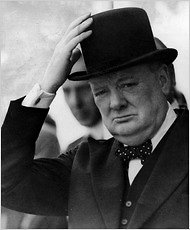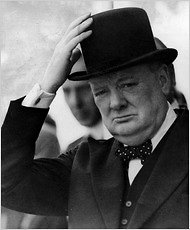
Bulletin #45 - Mar 2012
March 5, 1946 | Winston Churchill Warns of Soviet “Iron Curtain”

March 7, 2012
Remembering the anniversary of one of Churchill’s most famous post-war speeches.
By The Learning Network
THE NEW YORK TIMES, 5 March 2012—On March 5, 1946, Winston Churchill delivered his famous “Iron Curtain” speech, officially titled “Sinews of Peace,” at Westminster College in Fulton, Mo. After being introduced by President Harry Truman, Churchill, the former prime minister of Britain and now the opposition leader, warned of the threat posed by the Soviet Union, a World War II ally of Britain and the United States. Winston S. Churchill
Winston S. Churchill
The New York Times reported that “Mr. Churchill painted a dark picture of post-war Europe, on which ‘an iron curtain has descended across the Continent’ from Stettin in the Baltic to Trieste in the Adriatic.”

2025 International Churchill Conference
“He strongly intimated a parallel between the present position of the Soviet Union with that of Germany in 1935,” wrote The Times. “His words, he continued, were not offered in the belief that war with the Soviet Union was inevitable or imminent. He expressed the view that Russia does not desire war, but cautioned that Moscow does desire the fruits of war and the indefinite expansion of its power and policies.”
Churchill called on the United States to form a “fraternal association” with Britain. He said that the United States stood at the “pinnacle of world power” and must take responsibility to ensure peace in the world.
The American public reacted negatively to the speech. Americans still saw the Soviet Union as an ally and were shocked that Churchill would promote such a confrontational and provocative stance that could incite another war. Some U.S. politicians condemned the speech publicly while privately recognizing that the Soviet Union was indeed a looming threat.
Learn more about the “Iron Curtain” speech, including a video clip here
Churchill would be proven correct in time. The Soviet Union did continue to exert its influence over Eastern Europe and extend the “iron curtain.” In March 1947, just over a year after Churchill’s speech, President Truman issued the Truman Doctrine, which pledged U.S. support to countries in danger of falling into Communist hands. For over 40 years, the United States and Soviet Union fought for influence with other countries during the Cold War.
Connect to Today:
Since the fall of the Soviet Union, Russia has largely respected its neighbors’ borders and not attempted to form a new “iron curtain.” In August 2008, however, it went to war with neighboring Georgia in support of two ethnic enclaves that sought independence from Georgia. U.S. leaders defended Georgia and warned Russia not to become aggressive abroad.
Russian President Dmitri Medvedev accused the United States and N.A.T.O. of pushing it “down a path that is founded not on fully-fledged, civilized partnership with other countries, but on autonomous development, behind thick walls, behind an Iron Curtain.”
What do you think about Mr. Medvedev’s re-appropriation of the term “iron curtain” in this post-Cold War context? How does it differ from Churchill’s original metaphor? Which application of the term do you find more appropriate for today’s Russia: that Russia’s continued occupation of the enclaves in Georgia is an example of extending the iron curtain? Or, as Mr. Medvedev argues, is Russia being pushed behind a curtain by the international community that wants to force Russia into isolation? Why?
Read and discuss further on The New York Time Blog
All rights reserved ©The Learning Network
Subscribe
WANT MORE?
Get the Churchill Bulletin delivered to your inbox once a month.




